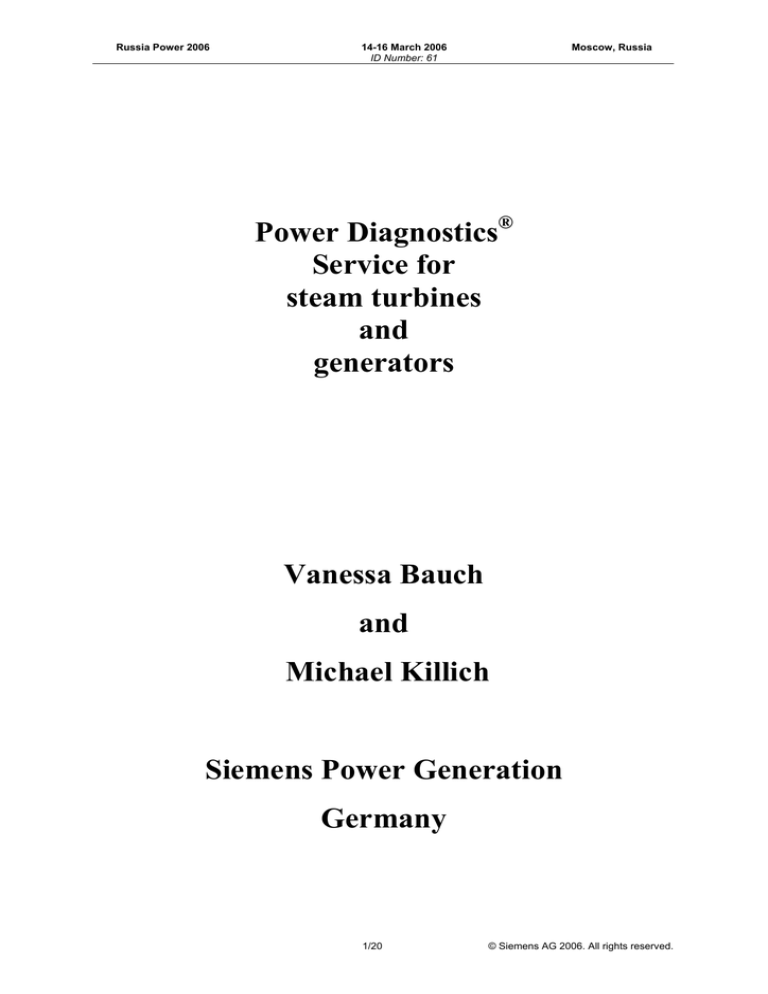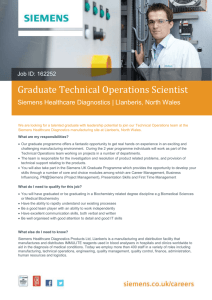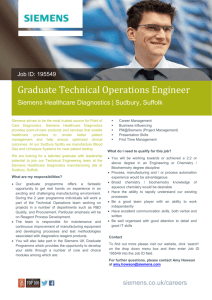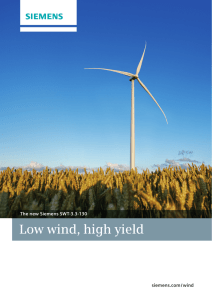
Russia Power 2006
14-16 March 2006
ID Number: 61
Moscow, Russia
Power Diagnostics®
Service for
steam turbines
and
generators
Vanessa Bauch
and
Michael Killich
Siemens Power Generation
Germany
1/20
© Siemens AG 2006. All rights reserved.
Russia Power 2006
14-16 March 2006
ID Number: 61
Moscow, Russia
Abstract
Due to market conditions we see a growing demand of flexibility in operating and
maintaining power plants. Power plants which were designed for base load operations have to
cycle and this has an enormous effect on the availability and reliability of the power plant and
the turbo-generator in particular. To keep the risk calculable it is of outmost importance to
know the condition of the machines. Another aspect is the necessity of flexibility due to price
changes on the electricity markets. During high price periods nobody wants to shut down for
a planned overhaul and it might by reasonable to use all the engineering reserves of the
machine and to operate it beyond its nominal design limits for some time.
These goals can only be reached when the condition of the power plant and its major
components can be assessed during normal operation using online diagnostics systems. But
online diagnostics does not mean a fully automated software solution, because a real
diagnostic can only be achieved using all the engineering capabilities and recourses in the
back offices of the turbo-generator manufacturers.
Another very important issue is the availability and the avoidance of forced outages using
such diagnostics. Used as a watch dog, diagnostics can help to make the business more safe
and predictable.
Siemens Power Diagnostics® therefore is designed as a remote expert centre where we offer
engineering support on a long term contractual basis. A software solution which is capable of
learning the normal behaviour of the plant prevents the engineers from dealing with trivial
occurrences. Using this software and the and the engineering knowledge, it is also possible to
decide that a turbo-generator running out of its normal operation limits concerning vibration
for example can be operated until the next planned outage evaluating the risk.
2/20
© Siemens AG 2006. All rights reserved.
Russia Power 2006
14-16 March 2006
ID Number: 61
Moscow, Russia
Introduction
Liberalization/deregulation of the electricity market continues to expand in many parts of the
world. This requires that power producer owners and operators deliver electricity more
efficiently and at competitive pricing. In parallel with these market demands, the operation of
the complete power plant – turbine, generator, boiler and auxiliaries – must improve
reliability, availability and utilization/efficiency.
But even in parts of the world not experiencing liberalization/deregulation the growing
demand in some regions for electricity is pushing power producers towards these same
improvements. Whatever the market environment, this is poses a special challenge for more
mature units, including base-load units that have to cycle and for plants that have not been
maintained for optimal performance.
To achieve these demands cost reduction and technical innovation programs were
implemented in power generation process. Furthermore, a higher flexibility in operating and
maintaining the plants is necessary according to the actual market conditions. Older base-load
units have to cycle, which creates higher stress on the materials. Planned overhauls are
postponed to avoid uneconomic standstill time. Uprating of power output of existing units to
the absolute design limits is often used as an additional option to tap maximum profit during
peak price periods. In parallel with all these market demands, operation of the complete
power plant with the steam turbine set and generator as key components must be enhanced
through higher reliability, availability and utilization.
The traditional way of handling maintenance business is not aligned to these market
requirements. One way to achieve the objective of flexible and short-term outage planning is
to use innovative technologies combined with close cooperation with the OEM.
There are a variety of solutions to help meet critical customer needs. Siemens Power
Generation is in the forefront of providing numerous solutions: proven modernization
designs, advanced inspection systems, new maintenance and repair services, and more. A
very powerful Siemens tool to improve plant availability is Siemens Power Diagnostics®. The
system features a modular structure focused on technical function groups of the power plant.
It works in combination with the conventional I&C system as an additional diagnostic tool
for early detection of condition changes or fault indication and for preventing unexpected
malfunctions. The use of comprehensive on-line data acquisition, internet data transmission
systems, task-related data analysis, and an expert background knowledge base at the Remote
Power Diagnostics® Centers enable detailed diagnosis of the actual plant condition.
3/20
© Siemens AG 2006. All rights reserved.
Russia Power 2006
14-16 March 2006
ID Number: 61
Moscow, Russia
With human expert support and engineering solutions from the manufacturer, together with
the knowledge-based supervisory diagnostic system, long term condition-based plant
operation with enhanced reliability and profitability will be possible. This Power Diagnostic®
Service enterprise encourages the client to
make inspection decisions on turbo set components on a condition- and risk-based
maintenance strategy,
implement better life-time management under technical and commercial aspects,
practice smoother turbo set operation for avoiding frequent overstressing of the
machine, resulting in life extension.
Condition monitoring with the Power Diagnostic® Service leads to effective live cycle asset
management.
Power Diagnostics®
Siemens Power Generation is offering Power Diagnostics® Services for steam power plants.
Today Siemens provides these services globally for more than 200 OEM installations for gas
turbines. The expertise on gas units is being applied to the entire steam plant island.
References
Equipment monitored by Power Diagnostics®
200
212
182
180
94 sites
Number of Units
160
156
129
140
120
100
80
60
40
99
20
0
Gas
Turbine
Generator
(Gas Turbine)
Steam
Turbine
11
11
41
Generator
Balance of
(Steam Turbine)
Plant
Figure 1: References
4/20
© Siemens AG 2006. All rights reserved.
Russia Power 2006
14-16 March 2006
ID Number: 61
Moscow, Russia
Power Diagnostics® is a comprehensive service with modular components designed to
monitor, analyze and diagnose the complete turbine island. This advanced service product is
a highly sophisticated remote diagnostic system. It combines global engineering experience,
sophisticated monitoring, data processing, trending, analysis tools, and security systems.
Different Parts work hand in hand and form the backbone of Power Diagnostics® Services
(see figure 2). Together they enable detailed diagnostics of the plant condition and support
development and implementation of condition-based maintenance strategies and the
optimization of the plant operations.
Power Diagnostics® Services performing analysis and diagnostics:
Using extensive OEM unit knowledge
Using advanced diagnostic tools/techniques
Providing trend analysis and problem identification
Providing root-cause analysis done by expert teams
Key elements of Power Diagnostics® Services
OEM engineering
expertise
OEM
engin
exper eering
tise
Onlin
e
acquis data
ition
Comprehensive online
data acquisition
Dat
proce a
ssin
analy g /
sis
Data processing /
analysis
Expe
know rt
led
netwo ge
rk
Use of an expert
knowledge network
Figure 2: Key Elements of Power Diagnostics® Services
5/20
© Siemens AG 2006. All rights reserved.
Russia Power 2006
14-16 March 2006
ID Number: 61
Moscow, Russia
On-line, real-time operating data acquired from customer locations are transmitted to the
Power Diagnostics® Centers. Data is acquired from sensors attached to customers’ turbines,
generators or auxiliaries. These are supported by PCs and the I&C system.
The infrastructure for the data handling process and the “intelligent” software is provided
from one of the Siemens Power Diagnostics® Centers (Mülheim, Erlangen and Orlando)
supplying the data acquisition, management and event-driven data storage. Data is
transmitted to the center and processed through a series of advanced modules and artificial
intelligence software to make sure that measured values do not exceed thresholds and
operating condition limits, and that the machine and/ or systems are running in a normal
mode with a predictable behavior.
Skilled Siemens engineers and specialists in various functions, such as thermodynamics, rotor
dynamics, fluid mechanics, processes and construction from Siemens departments in Orlando
and Mülheim are connected with the Power Diagnostics® Centers (see figure 3).
This engineering knowledge, combined with the use of advanced diagnostic tools and
techniques enable trending and analysis to address a broad range of operating needs that are
specific to each customer. The objective is early detection of abnormal operating conditions,
assessment by Siemens engineers and specialists and timely recommendations to customers.
Any necessary operating adjustments can be made or other actions taken to continue
successful performance and avoid unplanned downtime.
To summarize, the Power Diagnostics® Center performs analyses and diagnostics using
highly sophisticated learning software modules, provides trend analyses, problem
identification, and root-cause analyses conducted by human experts. The learning software
solution helps the experts to avoid spending their time and resources on minor issues. Also,
since the pool of information is coming from a large fleet, the experience base grows much
faster than it would from only a single plant. Even if no abnormal condition is detected in the
turbine-generator our engineering experts are able to generate recommendations on plant
operation and/or maintenance actions. These recommendations are designed to maximize the
equipment’s performance, reliability and availability and potentially extend outage intervals.
6/20
© Siemens AG 2006. All rights reserved.
Russia Power 2006
14-16 March 2006
ID Number: 61
Moscow, Russia
Power Diagnostics®
- Infrastructure for data handling
Power Diagnostics® Center
Your Power Plant
Worldwide network for
data exchange
Online real-time
operating data
transmission
Expert Network Team
Use of advanced diagnostic tools
and techniques for:
Reports
Monitoring of machine
conditions
Access
Data collection / processing
Analysis of limit values and
deviation from normal behavior
Info
Engineering Know-how:
Interpretation and diagnosis
Data assessment
Development of recommendations for future operations,
repairs and/or modernization
Analysis
14-16 March 2006
Russia Power
Monitoring
Offline Diagnosis
Power Generation 5
Online Diagnosis
Online Diagnosis
Bauch Vanessa, O263
©Siemens Power Generation 2004. All Rights Reserved
Figure 3: Data handling
There are close to 20 separate diagnostic modules in the Power Diagnostics® product line – In
introducing these services for operating steam turbine-generators, the following diagnostic
products are already available, with others to follow:
Shaft and bearing vibration
Monitoring of turbine generator vibration behavior by measuring shaft and bearing
vibration and operating variables over extended period.
End winding vibration
One of the turbine generator components that is subjected to the most stress are the
generator end windings. Despite the precision design and production that goes into
these items, the vibration behavior of the end winding nevertheless changes over the
course of operation as a result of ageing and thermal influences. Changes in vibration
behavior can occur as a result of disturbances in the grid, switching operations and
lightning strikes. An analysis of the condition of the end windings can be made by
acquiring these vibration (oscillation) levels.
7/20
© Siemens AG 2006. All rights reserved.
Russia Power 2006
14-16 March 2006
ID Number: 61
Moscow, Russia
Torsional Vibration
Electrical disturbances in the grid, switching operations and lightning strikes can
cause torsional vibration in power plant turbine generators, resulting in the line of
shafting being subjected to elevated, sometimes impermissible loading. This is why
measurement and evaluation of such events and processes is so important; this also
contributes to correct assessment of the condition of the turbine generator with respect
to condition-based maintenance.
All three types of vibrations can be handled on one hardware and software platform
VIBROCAM 5000
RF monitoring: Digital radio frequency measurement system, permits early detection
and indication of incipient damage. It is based on the detection of partial discharge
that results in short-circuiting across part of the insulation.
Krawal: A tool developed for plant design and engineering of the thermodynamic
processes integrated into online diagnostics to compare current process data with
anticipated values.
Currently 5 modules help collect the data
Basis for diagnostic works:
n
Bearing and Shaft Vibration Measurement
Enables vibration behavior assessment of a turbine island
o
End Winding Vibration Monitoring
Measures vibration levels at stator end windings to determine changes occurring within the generator
p
Torsional Vibration Monitor
Monitors vibration levels due to torsional excitation which can cause blade and / or rotor failures
q
Process engineering Tool (KRAWAL)
Thermodynamic module, which helps compare current process data with expected values
p
Radio Frequency Measurement System (SIEMON)
Monitors generators and high voltage equipment by partial discharge measurement
Figure 3: Steam Turbine Generator Product Portfolio
Figure 4: Overview of available service modules
8/20
© Siemens AG 2006. All rights reserved.
Russia Power 2006
14-16 March 2006
ID Number: 61
Moscow, Russia
Contract
The concept of Power Diagnostics® is designed to fit in Siemens Strategic Alliances
Programs (see figure 5). These long-term service contracts are designed to develop the
business from transactional and price-driven models to performance-driven contracts with
value-based pricing. Performance-driven, value-based pricing denotes mutually agreed
objectives such as availability, reliability or other customer benefits, measured and evaluated
in a Score Card. The prices for services ordered within such long-term contracts are therefore
fixed prices from a list of specifications plus a bonus / penalty based on the results of the
Score Cards.
The result is an integrated solution for deregulated markets where Siemens is more or less
responsible for all maintenance issues within the turbine island, i.e. the risk sharing level, the
level of goal alignment and the value-based pricing.
The idea of a value-based pricing and risk sharing is a key element in an Long Term Program
contract. One possibility to achieve this is by implementing Score Cards, developed and
mutually agreed upon during the negotiation process by the contract partners.
This concept of a value-based pricing system is available for Power Diagnostics® Service
Contract also. In this case the customer’s benefits have to be identified and fixed in a
mutually agreed matrix. These benefits can be in the form of events such as avoidance of a
forced outage or early detection of an imminent failure. Early detection, for example, gives
the customer additional time for planning and can therefore shorten the outage duration.
Expanded
Scope / Risk
Transactional
Performance
Driven
O&M
Mutual Benefit
Diagnostic
compatible data
collection: proactive
Operations &
Maintenance
Operating Plant
Service
Agreement
Project Managed
Maintenance
MC
Contract
Long Term
Program
OPSA
LTP
ce
n
a
i
All
s
Minimum of
continous costs
TFA
Technical Field Assistance
TMS
Total Maintenance Services
Today:
• Fire fighting
• Reactive
Figure 5: Overview Strategic Alliance Programs
9/20
© Siemens AG 2006. All rights reserved.
Russia Power 2006
14-16 March 2006
ID Number: 61
Moscow, Russia
Customer Benefits
Increasing cost pressure in power generation forces power plant operators to optimize service
and maintenance and to maintain or even improve reliability and availability . This objective
can be reached by applying a condition-based maintenance strategy. Siemens Power
Diagnostics is a powerful tool to support the power plant operator in achieving this objective
But only with the combination of on- and off-line measurements / monitoring can a high
degree of assessment quality be attained.
The goal of Power Diagnostics® Services is to help identify, assess and diagnose plant
operating abnormalities that could result in inefficiency and forced outages. Also, the
system's condition monitoring capabilities offer more effective life cycle asset management,
which is especially important for flexible operation of base-load units.
For plant operators, the provision of advance detection of abnormal operating conditions and,
ultimately, follow-up actions can result in optimized operation, higher availability and
improved turbine island efficiency. For the original equipment manufacturer, information
collected through Power Diagnostics® can be used to further improve products and services,
including improvements in hardware service life and durability, to mitigate collateral
equipment damage through early detection, to enhance reliability, and to improve scheduling
and optimize the duration of maintenance outages.
Results from Power Diagnostics® can contribute to development of recommendations for
future operations, repairs and/or modernization of customer’s equipment.
This Power Diagnostics® Service encourages the customer to:
Make inspection decisions on turbo set components in terms of a condition- and riskbased maintenance strategy
Improve life-time management through improved data and data analysis
Improve turbo set operation to avoid frequent overstressing for potential life
extension.
The bottom line is this: Siemens Power Diagnostics® Services can help identify a problem
before it impacts operation, allowing plant personnel to make necessary adjustments for
continued operation. In some cases Power Diagnostics® can help turn an unplanned shutdown
into a scheduled outage with all the personnel and materials needed to help make optimal use
of the customer’s time and money (see figure 6 and case study).
10/20
© Siemens AG 2006. All rights reserved.
Russia Power 2006
14-16 March 2006
ID Number: 61
Moscow, Russia
Signal progression
Limit Value
Start-up
Shut down
Superior
limit value
Stand still
Identifiable Trend Æ
Early detection of an
unplanned stand still
by diagnostic experts.
t
Preparation
for the
stand still
Delta t
Economized time in fact of
early problem detection and
change from an unplanned to
a planned stand still.
Figure 6: Benefit of an early damage detection
For the short term Power Diagnostics® provides the power plant operator with regular
documentation of the monitored components on a high quality data basis. In case of recurring
problems and/or detected operation abnormalities/trends etc., exclusive access to the
engineering network with guaranteed capacities is provided. A Power Diagnostics® customer
is treated as a preferred customer. Based on continuous monitoring and comparison with the
historical data, early detection of problems and damages can be realized. This helps the
power plant operator to save costs and to increase sales. But it also offers the possibility to
continue plant operation with justifiable risks, for example in phases with high prices on the
electricity market.
For the long term Power Diagnostics® forms the basis for
Condition-based maintenance
Flexible operation
Life-time extension
Maintaining optimum efficiency
Availability enhancement
11/20
© Siemens AG 2006. All rights reserved.
Russia Power 2006
14-16 March 2006
ID Number: 61
Moscow, Russia
Summary and Outlook
Power Diagnostics® services …
can provide …
are the basis
for …
in combination
with long term
service contracts
…
3
3
3
3
3
3
3
3
3
3
3
3
3
3
3
3
3
3
3
3
Regular documentation of machine conditions
Access to the Siemens Expert Network
Early detection of many operating issues
Information for proactive decision making
Condition-based maintenance
Flexible operation
Efficiency/ Availability/ Reliability Improvement
Risk sharing, extended warranties
Performance related payment
Cost savings
Figure 7: Customer Benefits on short term and long term view
12/20
© Siemens AG 2006. All rights reserved.
Russia Power 2006
14-16 March 2006
ID Number: 61
Moscow, Russia
Case study
Online diagnostics does not mean relying exclusively on software solutions. It is the
combination of skilled OEM personnel, the operation experience of an entire fleet and the
application of advanced diagnostic tools that make for success.
The basis for successful diagnostic work is formed by the high quality data pool, combined
with a powerful hardware and software system for data processing and an expert team for
data assessment. The interaction of an advanced monitoring/ analysis system and experts
leads to an established statement about machine behavior, as well as to an observation of
problem causes and recommendation for the elimination of the problem.
Requirements for a vibration analysis and monitoring system:
Diagnosis-oriented data acquisition
Diagnosis-oriented data analysis and data reduction to meaningful key
parameters with a minimum loss of information
Diagnosis-oriented data processing for off-line diagnostics by experts
Automatic determining of the machine-model-specific and measuring-point-specific
normal conditions and behavior of the key parameters within the excursion for normal
operating parameters
Diagnosis-oriented monitoring – automatic evaluation of key parameters as compared
to the values for normal conditions and behavior, with data archiving in the event of
deviation from normal conditions.
All of these requirements are fulfilled by the Vibrocam5000 hardware and software systems.
The following example illustrates the procedure to take in the event that vibration problems
arise. Power Diagnostics® has demonstrated its abilities already several times as in the
following case:
4 weeks ahead of a planned outage in a turbine-generator set all measured vibration values
are in normal range, but variations in the generator rotor data were detected. An additional
measurement was carried out and the resulting data were analyzed and assessed by the
Siemens Power Diagnostics® Expert Team. The result of the measurement was the detection
of a crack in the axial water guidance in the protection sleeves of the generator rotor. It was
recommended to exchange the complete rotor in order to get the power plant back in
operation.
Through early detection and planning work the rotor was exchanged at the scheduled outage
using a pool rotor: Chances of finding the crack during the scheduled outage were very low,
13/20
© Siemens AG 2006. All rights reserved.
Russia Power 2006
14-16 March 2006
ID Number: 61
Moscow, Russia
since the scope did not include the generator. Power Diagnostics® Services were significant
in preventing a forced outage.
The turbine-generator set has one high pressure and two low pressure turbines and a water
cooled generator. The turbine and generator side at the low pressure turbine, the turbine and
exciter side at the generator, the exciter bearing and the shaft pump were examined by
vibration test points (see figure 8).
System configuration
Absolute bearing vibrations (mm/s)
Relative shaft vibrations (µm)
Figure 8: System configuration and vibration test points
Examination of the vibration behavior between 10th February – 10th March showed changes
in the vibration behavior as from 21. February (see figure 9). The measurement values were
still under the limit values so the operator was not really alarmed. Concerning vibration
issues changes are always indications, even if limit values were not exceeded therefore the
situation was seen as a task force issue.
In order to get a detailed view of the vibrations the summarized values of the amplitudes as
well as the vibration vectors were examined. The vibration vectors showed high changes of
the vibration level - about three times higher. The high variations of the vibration level
indicate a generator vibration problem (see figure 10).
14/20
© Siemens AG 2006. All rights reserved.
Russia Power 2006
14-16 March 2006
ID Number: 61
Moscow, Russia
Vibration behavior
between 10th February – 10th March 2005
Change of vibration behavior
as from 21.02.05
Figure 9: Vibration behavior between 10th February and 10th March
Comparison 2th February and 30th March 2005
LP2 Bearing –
Turbine side
LP2 Bearing –
Generator side
Generator Bearing –
Turbine side
2th February = dark blue
stable
Generator Bearing –
Exciter side
Extended
changes
Exciter Bearing
30th March = light blue
Shaft Pump
Figure 10: Comparison 2nd February and 30th March
15/20
© Siemens AG 2006. All rights reserved.
Russia Power 2006
14-16 March 2006
ID Number: 61
Moscow, Russia
Experts gather from the significant changes of the vibration levels based on the know-how
from development & design and the experience an exciter current depending issue. On this
account a correlation vibration behavior versus excitation current was realized. Following
distinctive features could be determined
No linear correlation between exciter current and vibration level
Increased vibrations at higher and lower excitation current
Lowest vibration level at 6,8 kA excitation current
(see figure 11)
Vibration behavior
versus excitation current
Lowest
Vibration level at 6,8 kA
excitation current
Increased vibrations
at higher and lower
excitation current
Figure 11: Vibration behavior versus excitation current
Based on this results following statements were made:
The typical vibration behavior with regard to the exciter current influence has been
changed since 21. February
There has to be an additional influencing parameter which has a high dependency on
the exciter current and causes the vibration
One possible reason for this behavior could be the influence of the primary cooling water
temperature on the vibration behavior. An additional test was realized to analyze the behavior
of the vibration by changing cooling water temperature under constant excitation current.
The result of the test showed that the machine had an identical behavior (see figure 12).
16/20
© Siemens AG 2006. All rights reserved.
Russia Power 2006
14-16 March 2006
ID Number: 61
Moscow, Russia
Comparison: changes due to reactive power <>
changes due to primary water temperature
Changes of the reactive power
Changes of the primary water
temperature
>> the reaction of the machine is identical
Figure 12: Comparison: changes due to reactive power versus changes due to primary water
temperature
Based on the generator design a crack in the axial water guidance was assumed (see figure
13).
During the standstill a crack in the axial water guidance in the protection sleeves of the
generator rotor was detected. About 1,8 liters of water were located in the air gap between
water guidance and rotor. The complete rotor was exchanged in order to get the power plant
back in operation.
The crack was located on one cooling water pipe. Due to the water in the air gaps a better
heat transfer could take place which leads to a thermal unbalance within the rotor. Only when
the rotor and the cooling water temperature were on the same level there was no heat flow
and so far no vibrations. This happened at about 6,8 KA (the point of the lowest vibration
level)
17/20
© Siemens AG 2006. All rights reserved.
Russia Power 2006
14-16 March 2006
ID Number: 61
Moscow, Russia
Old generator shaft design – Cooling
Spare rotor / water guidance (Protective pipe)
cam direction by
protection pipe
weld
cam direction by
protection pipe
weld
water chamber
R
a
d
i
a
l
pi
p
e
water chamber
R
a
d
i
a
l
pi
p
e
relative
movement
relative
movementdue
duetotoshaft
shaft bending
bending
Axial
waterguidance
guidance
Axial
water
3mm
3mm
Compensator
Compensator
12mm
12mm
2120mm
2120mm
welds
welds
Figure 13: Old generator shaft design – Cooling spare roter/ water guidance (protective pipe)
On the sketch in figure 6 you can see the generator cooling design.
The rotor is equipped with 4 cooling water pipes (2 water supplies, 2 drain pipes)
The cooling pipes are fixed with welded cams.
The relative movement due to shaft bending leads can lead to cracks in the weld of the
pipe
Based on the above mentioned case study two main points can be pointed out:
Continuous monitoring is important to ensure early detection of operation issues in
this way time and money can be saved.
The know-how from development and design as well as the know-how and
experience of specialists are necessary to solve problems in a fast and responsive way.
18/20
© Siemens AG 2006. All rights reserved.
Russia Power 2006
14-16 March 2006
ID Number: 61
Moscow, Russia
Summary
Due to the changing market conditions all over the world, the traditional way of dealing with
maintenance business no longer fits in with these new environmental requirements. The
solution is to achieve a flexible and short-term outage planning process and a reduction of
costs. Diagnostics, in particular in combination with Strategic Alliances, can fulfill all these
demands, as they are tailor made solutions.
Monitoring and diagnostics is a rapidly evolving field in power generation. The combination
of available IT technology and on-line expertise provides cost-efficient service and benefits
to the customer.
In summary:
Increasingly more specific analysis and diagnostic technology is now available
To maximize the benefits for power plants, the challenge is to employ all requisite
technologies via a single platform
Global networking of a running fleet enables OEM experts to analyze data quickly and
respond rapidly to customer requirements
On-line diagnostics - in combination with remote expert knowledge - is the key to
condition-based maintenance and provides cost-efficient service for reliable plant
operation.
For the customer, it is important in any given situation to have access through a diagnostic
platform to the knowledge of the people who designed his equipment. For the equipment
supplier, the greatest benefit is to have live feedback from his own "running technical
systems" that enables him to optimize his own learning process.
And last but not least, on-line diagnostics paves the way from scheduled maintenance to
condition-based maintenance, thus helping customers operate their units at maximum
profitability.
19/20
© Siemens AG 2006. All rights reserved.
Russia Power 2006
14-16 March 2006
ID Number: 61
Moscow, Russia
Literature
[1] Taud R.; Scheidel M.: Use and Experience with Gas Turbine On-Line Diagnostics, Power Gen
Europe, Barcelona 2004
[2] Bender, K.; Grühn, M.; Rukes, B.; Scheidel, M.: Online Remote Diagnosis of Turbosets and
Combined Cycle Power Plants;
VDI-Bericht Nr.: 1641, VDI-Verlag, Düsseldorf, 2001
[3] Adam, G.; Bode, A.: Ferndiagnose und Teleservicesystem für GUD-Kraftwerke;
VDI-Bericht Nr.: 1566, VDI-Verlag, Düsseldorf, 2000
[4] Brummel, H.-G.; Scheidel, M.; Thompson, E.: Gut behütet aus der Ferne;
Siemens Power Journal, Heft 1/00
[5] Ulbrich, A; Gobrecht E.; Siegel M. R.; Brückner J.: High Steam Turbine Operating
Flexibility Coupled with Service Interval Optimization, Power Gen Europe, Barcelona 2004
20/20
© Siemens AG 2006. All rights reserved.







